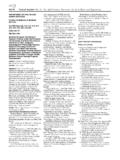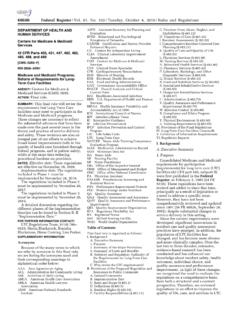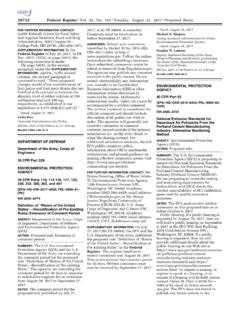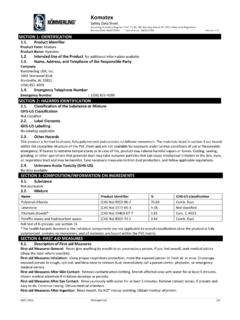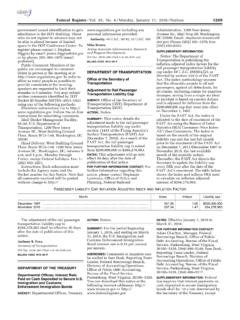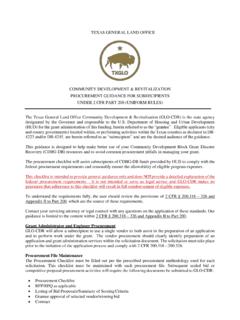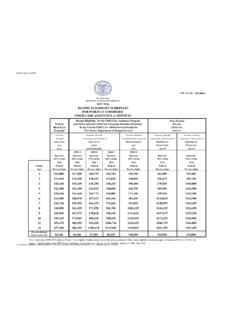Transcription of Department of Housing and Urban Development
1 Vol. 78 Friday, No. 32 February 15, 2013 Part IV Department of Housing and Urban Development 24 CFR Part 100 Implementation of the Fair Housing Act s Discriminatory Effects Standard; Final Rule VerDate Mar<15>2010 19:38 Feb 14, 2013 Jkt 229001 PO 00000 Frm 00001 Fmt 4717 Sfmt 4717 E:\FR\FM\ 15 FER3 TKELLEY on DSK3 SPTVN1 PROD with RULES311460 federal Register/ Vol. 78, No. 32 / Friday, February 15, 2013 / Rules and Regulations 1 This preamble uses the term disability to refer to what the Act and its implementing regulations term a handicap. Both terms have the same legal meaning. See Bragdon v. Abbott, 524 624, 631 (1998). 2 See nn. 12, 28, supra, discussing HUD administrative decisions and federal court rulings. Department OF Housing AND Urban Development 24 CFR Part 100 [Docket No.]
2 FR 5508 F 02] RIN 2529 AA96 Implementation of the Fair Housing Act s Discriminatory Effects Standard AGENCY: Office of the Assistant Secretary for Fair Housing and Equal Opportunity, HUD. ACTION: Final rule. SUMMARY: Title VIII of the Civil Rights Act of 1968, as amended (Fair Housing Act or Act), prohibits discrimination in the sale, rental, or financing of dwellings and in other Housing -related activities on the basis of race, color, religion, sex, disability, familial status, or national , which is statutorily charged with the authority and responsibility for interpreting and enforcing the Fair Housing Act and with the power to make rules implementing the Act, has long interpreted the Act to prohibit practices with an unjustified discriminatory effect, regardless of whether there was an intent to discriminate. The eleven federal courts of appeals that have ruled on this issue agree with this interpretation.
3 While HUD and every federal appellate court to have ruled on the issue have determined that liability under the Act may be established through proof of discriminatory effects, the statute itself does not specify a standard for proving a discriminatory effects violation. As a result, although HUD and courts are in agreement that practices with discriminatory effects may violate the Fair Housing Act, there has been some minor variation in the application of the discriminatory effects standard. Through this final rule, HUD formalizes its long-held recognition of discriminatory effects liability under the Act and, for purposes of providing consistency nationwide, formalizes a burden-shifting test for determining whether a given practice has an unjustified discriminatory effect, leading to liability under the Act. This final rule also adds to, and revises, illustrations of discriminatory Housing practices found in HUD s Fair Housing Act regulations.
4 This final rule follows a November 16, 2011, proposed rule and takes into consideration comments received on that proposed rule. DATES: Effective Date: March 18, 2013. FOR FURTHER INFORMATION CONTACT: Jeanine Worden, Associate General Counsel for Fair Housing , Office of General Counsel, Department of Housing and Urban Development , 451 7th Street SW., Washington, DC 20410 0500, telephone number 202 402 5188. Persons who are deaf, are hard of hearing, or have speech impairments may contact this phone number via TTY by calling the federal Relay Service at 800 877 8399. SUPPLEMENTARY INFORMATION: I. Executive Summary A. Purpose of Regulatory Action Need for the Regulation. This regulation is needed to formalize HUD s long-held interpretation of the availability of discriminatory effects liability under the Fair Housing Act, 42 3601 et seq., and to provide nationwide consistency in the application of that form of liability.
5 HUD, through its longstanding interpretation of the Act, and the eleven federal courts of appeals that have addressed the issue agree that liability under the Fair Housing Act may arise from a facially neutral practice that has a discriminatory effect. The twelfth court of appeals has assumed that the Fair Housing Act includes discriminatory effects liability, but has not decided the issue. Through four decades of case-by-case application of the Fair Housing Act s discriminatory effects standard by HUD and the courts, a small degree of variation has developed in the methodology of proving a claim of discriminatory effects liability. This inconsistency threatens to create uncertainty as to how parties conduct will be evaluated. This rule formally establishes a three-part burden- shifting test currently used by HUD and most federal courts, thereby providing greater clarity and predictability for all parties engaged in Housing transactions as to how the discriminatory effects standard applies.
6 How the Rule Meets the Need. This rule serves the need described above by establishing a consistent standard for assessing claims that a facially neutral practice violates the Fair Housing Act and by incorporating that standard in HUD s existing Fair Housing Act regulations at 24 CFR By formalizing the three-part burden- shifting test for proving such liability under the Fair Housing Act, the rule provides for consistent and predictable application of the test on a national basis. It also offers clarity to persons seeking Housing and persons engaged in Housing transactions as to how to assess potential claims involving discriminatory effects. Legal Authority for the Regulation. The legal authority for the regulation is found in the Fair Housing Act. Specifically, section 808(a) of the Act gives the Secretary of HUD the authority and responsibility for administering this Act.
7 (42 3608(a)). In addition, section 815 of the Act provides that [t]he Secretary may make rules (including rules for the collection, maintenance, and analysis of appropriate data) to carry out this title. The Secretary shall give public notice and opportunity for comment with respect to all rules made under this section. (42 3614a.) HUD also has general rulemaking authority, under the Department of Housing and Urban Development Act, to make such rules and regulations as may be necessary to carry out its functions, powers, and duties. (See 42 3535(d).) B. Summary of the Major Provisions This rule formally establishes the three-part burden-shifting test for determining when a practice with a discriminatory effect violates the Fair Housing Act. Under this test, the charging party or plaintiff first bears the burden of proving its prima facie case that a practice results in, or would predictably result in, a discriminatory effect on the basis of a protected characteristic.
8 If the charging party or plaintiff proves a prima facie case, the burden of proof shifts to the respondent or defendant to prove that the challenged practice is necessary to achieve one or more of its substantial, legitimate, nondiscriminatory interests. If the respondent or defendant satisfies this burden, then the charging party or plaintiff may still establish liability by proving that the substantial, legitimate, nondiscriminatory interest could be served by a practice that has a less discriminatory effect. This rule also adds and revises illustrations of practices that violate the Act through intentional discrimination or through a discriminatory effect under the standards outlined in C. Costs and Benefits Because the rule does not change decades-old substantive law articulated by HUD and the courts, but rather formalizes a clear, consistent, nationwide standard for litigating discriminatory effects cases under the Fair Housing Act,2it adds no additional costs to Housing providers and others engaged in Housing transactions.
9 Rather, VerDate Mar<15>2010 19:38 Feb 14, 2013 Jkt 229001 PO 00000 Frm 00002 Fmt 4701 Sfmt 4700 E:\FR\FM\ 15 FER3 TKELLEY on DSK3 SPTVN1 PROD with RULES311461 federal Register/ Vol. 78, No. 32 / Friday, February 15, 2013 / Rules and Regulations 342 3601. 4 Trafficante v. Metro. Life Ins. Co., 409 205, 211 (1972) (internal citation omitted). 5Id. at 209. 6Id. at 211. 7H. Res. 1095, 110th Cong., 2d Sess., 154 Cong. Rec. H2280 01 (April 15, 2008) (2008 WL 1733432). 8 See 42 3608(a). 9 See 42 3610, 3612. 10 See 42 3614a. 11 Havens Realty Corp. v. Coleman, 455 363, 380 (1982). 12 See, , HUD v. Twinbrook Village Apts., No. 02 00025600 0256 8, 2001 WL 1632533, at *17 (HUD ALJ Nov. 9, 2001) ( A violation of the [Act] may be premised on a theory of disparate impact. ); HUD v. Carlson, No. 08 91 0077 1, 1995 WL 365009 (HUD ALJ June 12, 1995) ( A policy or practice that is neutral on its face may be found to be violative of the Act if the record establishes a prima facie case that the policy or practice has a disparate impact on members of a protected class, and the Respondent cannot prove that the policy is justified by business necessity.)
10 ; HUD v. Ross, No. 01 92 0466 18, 1994 WL 326437, at *5 (HUD ALJ July 7, 1994) ( Absent a showing of business necessity, facially neutral policies which have a discriminatory impact on a protected class violate the Act. ); HUD v. Carter, No. 03 90 0058 1, 1992 WL 406520, at *5 (HUD ALJ May 1, 1992) ( The application of the discriminatory effects standard in cases under the Fair Housing Act is well established. ). 13 HUD v. Mountain Side Mobile Estates P ship, No. 08 92 0010 1, 1993 WL 307069 (HUD Sec y July 19, 1993), aff d in relevant part, 56 1243 (10th Cir. 1995). 14 Brief for HUD Secretary as Respondent, Mountain Side Mobile Estates P ship v. HUD, No. 94 9509 (10th Cir. 1994). 15 HUD v. Pfaff, No. 10 93 0084 8, 1994 WL 592199, at *17 (HUD ALJ Oct. 27, 1994), rev d on other grounds, 88 739 (9th Cir. 1996). 16 Brief for HUD Secretary as Respondent, Pfaff v.










